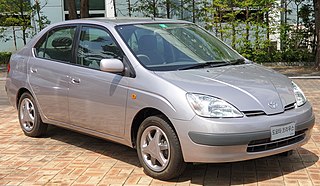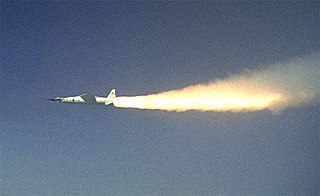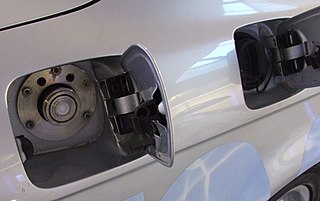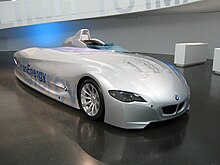
A ramjet is a form of airbreathing jet engine that uses the forward motion of the engine to take in air for combustion that produces jet thrust. Since it produces no thrust when stationary, ramjet-powered vehicles require an assisted take-off like a rocket assist to accelerate it to a speed where it begins to produce thrust. Ramjets work most efficiently at supersonic speeds around Mach 3 and can operate up to speeds of Mach 6.

A hybrid vehicle is one that uses two or more distinct types of power, such as submarines that use diesel when surfaced and batteries when submerged. Other means to store energy include pressurized fluid in hydraulic hybrids.

A hydrogen vehicle is a vehicle that uses hydrogen fuel for motive power. Hydrogen vehicles include hydrogen-fueled space rockets, as well as ships and aircraft. Motive power is generated by converting the chemical energy of hydrogen to mechanical energy, either by reacting hydrogen with oxygen in a fuel cell to power electric motors or, less commonly, by burning hydrogen in an internal combustion engine.

Fuel efficiency is a form of thermal efficiency, meaning the ratio of effort to result of a process that converts chemical potential energy contained in a carrier (fuel) into kinetic energy or work. Overall fuel efficiency may vary per device, which in turn may vary per application, and this spectrum of variance is often illustrated as a continuous energy profile. Non-transportation applications, such as industry, benefit from increased fuel efficiency, especially fossil fuel power plants or industries dealing with combustion, such as ammonia production during the Haber process.

Blue Flame is a rocket-powered land speed racing vehicle that was driven by Gary Gabelich and achieved a world land speed record on Bonneville Salt Flats in Utah on October 23, 1970. The vehicle set the FIA world record for the flying mile at 622.407 mph (1,001.667 km/h) and the flying kilometer at 630.388 mph (1,014.511 km/h). Blue Flame's world records have since been broken.

The NASA X-43 was an experimental unmanned hypersonic aircraft with multiple planned scale variations meant to test various aspects of hypersonic flight. It was part of the X-plane series and specifically of NASA's Hyper-X program developed in the late 1990s. It set several airspeed records for jet aircraft. The X-43 is the fastest jet-powered aircraft on record at approximately Mach 9.6.
Shell Eco-marathon is a world-wide energy efficiency competition sponsored by Shell. Participants build automotive vehicles to achieve the highest possible fuel efficiency. There are two vehicle classes within Shell Eco-marathon: Prototype and UrbanConcept. There are three energy categories within Shell Eco-marathon: battery-electric, hydrogen fuel cell, and internal combustion engine. Prizes are awarded separately for each vehicle class and energy category. The pinnacle of the competition is the Shell Eco-marathon Drivers' World Championship, where the most energy-efficient UrbanConcept vehicles compete in a race with a limited amount of energy.

Olafur Eliasson is an Icelandic–Danish artist known for sculptured and large-scaled installation art employing elemental materials such as light, water, and air temperature to enhance the viewer's experience.
The Buckeye Bullet is a series of four experimental electric cars created by students from Ohio State University as a joint project with Venturi. The cars were designed to break the land speed record on the Bonneville Speedway, a salt flat just outside Wendover, Utah, United States. The team first achieved its goal in October 2004, at 271.737 mph (437.318 km/h) for the one mile world record, repeatedly increasing the record until setting a mile world record of 307.666 mph (495.140 km/h), in 2009, and a one kilometer world record of 341.264 mph (549.211 km/h), in 2016.
Hybrid vehicle drivetrains transmit power to the driving wheels for hybrid vehicles. A hybrid vehicle has multiple forms of motive power.

The BMW Hydrogen 7 is a limited production hydrogen internal combustion engine vehicle built from 2005-2007 by German automobile manufacturer BMW. The car is based on BMW’s traditional petrol-powered BMW 7 Series (E65) line of vehicles, and more specifically the 760Li. It uses the same 6-litre V-12 motor as does the 760i and 760Li; however, it has been modified to also allow for the combustion of hydrogen as well as petrol, making it a bivalent engine. Unlike many other current hydrogen powered vehicles like those being produced by Hyundai, Honda, General Motors, and Daimler AG – which use fuel cell technology and hydrogen to produce electricity to power the vehicle – the BMW Hydrogen 7 burns the hydrogen in an internal combustion engine.

The Mazda Premacy Hydrogen RE Hybrid or Mazda5 Hydrogen RE Hybrid was a hydrogen powered hybrid car produced by Mazda. Later models were also called the Mazda Hydrogen RE Plug in Hybrid. The first car was unveiled in 2005, with an improved version shown at the 2007 Tokyo Motor Show. Mazda planned for the car to enter production and leased a few cars to end users in 2009 in 2010.

A hydrogen internal combustion engine vehicle (HICEV) is a type of hydrogen vehicle using an internal combustion engine. Hydrogen internal combustion engine vehicles are different from hydrogen fuel cell vehicles. Instead, the hydrogen internal combustion engine is simply a modified version of the traditional gasoline-powered internal combustion engine. The absence of carbon means that no CO2 is produced, which eliminates the main greenhouse gas emission of a conventional petroleum engine.

The Mercedes-Benz BlueZERO concept is Mercedes' attempt at the alternative fuel vehicle movement. The BlueZERO is a flexible concept that has the ability to accommodate the three different types of future alternative fuels: electric, hybrid, and hydrogen fueled. It was first introduced at the 2009 Detroit Auto Show which took place January 11–25. It features a single vehicle architecture that accommodates three models with different electric power-train configurations, each of which are fully developed and ready for testing. The Mercedes-Benz BlueZERO electric drive system gives each model the same performance specifications for acceleration and top speed. The Mercedes-Benz BlueZERO electric drive modular design accelerates from 0 to 100 km/h (62.5 mph) in under 11 seconds, and the top speed is electronically governed to 150 km/h (93 mph) in the interests of optimal range and energy efficiency. Peak torque is 320 N⋅m (236 lb⋅ft) and as with all EVs, maximum torque is available from zero rpm.

The BMW i8 is a plug-in hybrid sports car developed by BMW. The i8 was part of BMW's electrified fleet and was marketed under the BMW i sub-brand. The production version of the BMW i8 was unveiled at the 2013 Frankfurt Motor Show and was released in Germany in June 2014. Deliveries to retail customers in the U.S. began in August 2014. A roadster variant was launched in May 2018. Production ended in June 2020.
Raymond Freymann is an engineering professor and researcher, born on 30 May 1952 in Esch-sur-Alzette, Luxembourg, and has authored or co-authored more than 150 scientific publications. He has served BMW for 25 years and held the position of CEO of BMW Group Research and Technology from 2003 to 2011

Alset Global GmbH is an Austrian technology and engineering company based in Graz that is specialized in hydrogen-based clean mobility products. Alset Global developed a Hybrid Hydrogen system of which the technology is patented. According to Alset Global, this technology is unique as it offers to run an internal combustion engine on either pure petrol, pure hydrogen or a combination of both. The technology offers a new sustainable and clean alternative to the automotive industry. The technology has been developed to create an alternative technology to meet new emission target levels. In addition, Alset Global is specialised in hydrogen system integration, hydrogen gas storage, and software development to utilize the hydrogen hybrid technology in the automotive industry.

The Kawasaki Ninja H2 is a supercharged four-stroke supersport-class motorcycle in the Ninja sports bike series manufactured by Kawasaki, featuring a variable-speed centrifugal supercharger.

The Mazda HR-X was the first hydrogen powered concept car produced by Mazda. The car was unveiled at the Tokyo Motor Show in 1991. The car seated four people in a plastic shell and was powered by a two rotor Wankel engine which propelled it to 130 km/h (81 mph). The hydrogen was stored in a cooled metal hydride tank and 3.32 kilograms (7.3 lb) provided a range of 190 km (120 mi). It was the first in a series of demonstration hydrogen internal combustion engine vehicles produced by Mazda.
















